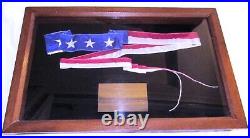
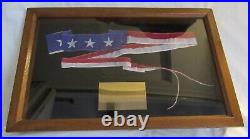
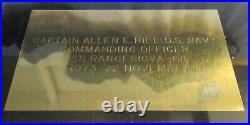
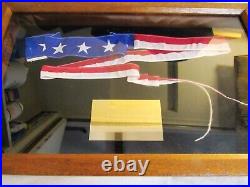

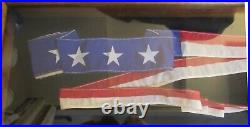
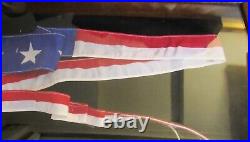

THIS IS A US NAVY USS RANGER CVA-61 DECOMMISSIONING PENNANT FROM THE ESTATE OF REAR ADMIRAL ALLEN “BOOT” HILL… PLEASE SEE MY OTHER AUCTIONS FOR MANY MORE PLAQUES FROM THE ESTATE OF ALLEN BOOT HILL… BELOW IS THE HISTORY OF REAR ADMIRAL HILL.. Passing of Rear Adm. USN (retired) Director of Naval History and Heritage Command, Curator for the Navy. It is with deep regret I inform you of the passing of Rear Admiral Allen Edward’Boot’ Hill, U. Navy (Retired) on December 18, 2020 at age 92. Boot enlisted in the U. Naval Reserve in May 1946 and served as a Naval Aviator until his retirement in August 1980 as Director, Battle Group Readiness (OP-953) in the Office of the Chief of Naval Operations. In his distinguished career he flew combat missions in both the Korean and Vietnam Wars, earning two Legion of Merit with Combat V, four Distinguished Flying Crosses, two Bronze Stars with Combat V, 26 Air Medals, a Purple Heart and other combat awards. His commands included Attack Squadron 192, Attack Carrier Air Wing TWO, USS Duluth (LPD 6). USS Ranger (CVA 61). And Training Command Pacific. He played a key role in the creation of Tactical Training Groups Atlantic and Pacific. Rear Admiral Jay’Rabbit’ Campbell, USN Ret. Notified me of Rear Admiral Hill’s passing and provided the following obituary he wrote for Golden Eagles. I really can’t improve upon it, so I forward as is with only a couple minor additions. It is my sad duty to report that on December 18, 2020, Golden Eagle Rear Admiral Allen E. Boot’ Hill, USN (Retired) made his Last Take Off following hospitalization due to an injury he suffered when he fell earlier in December. His son, Scott reported that he passed peacefully, surrounded by family despite COVID-19 restrictions, because he was moved to the Hospice Care facility at Riverside Community Hospital. Hill was raised in Riverside, Calif. And became fascinated with aviation while watching aircraft flying from the nearby Riverside Municipal Airport. He began his career as an Aviation Midshipman in April 1948 after graduating from high school and quickly demonstrated his leadership potential, becoming Midshipman Battalion Commander, despite receiving “consecutive Class’A’ offenses, ” being restricted for three months and becoming good at shining shoes and polishing brass. Boot received his Wings of Gold on January 20, 1950 and after two months of jet transition training in the F-80. He joined his first fleet squadron, VF-112 in March 1950, flying the F9F-2. Initially based at NAS North Island, Calif. The squadron was among the first to deploy at the outbreak of the Korean War from July 1950 – April 1951, embarked in USS Philippine Sea. As a “nugget” wingman for the C. Of VF-112, Boot “listened and learned” from the cadre of WWII-experienced pilots in the squadron as they entered combat immediately after arriving on station. During this first deployment he participated in the first all jet and highest air-to-air engagement in air warfare history on November 9, 1950 at 36,000 feet over the Yalu river. He also flew in support of the Marines at the Chosin Reservoir before the conclusion of the deployment and return to CONUS in April 1951. After a brief turnaround during which, as a combat veteran, then Ensign Hill was designated a Division Leader, training a Lieutenant Commander, Lieutenant and Lieutenant (junior grade) before the squadron made a second Korean War deployment from December 1951 – July 1952, again embarked in USS Philippine Sea. During this deployment Boot became an early jet centurion. Having achieved over 100 traps on a straight deck carrier, Boot stated, they hadn’t yet even invented 100-landing patches. Boot Hill began his first shore tour as Officer in Charge of FASRON12 at Ream Field flying F9F. ADs and TBMs for six months before transferring to Pensacola, FL for duty as a Flight Instructor in April 1953. Initially flying the SNJ from Saufley Field, in October he became the Director, Tactics Standardization and IBTU Flight Instructor at NAS Pensacola. In September 1954 he was selected to complete his Bachelor’s Degree in a two year program at the University of California, Berkeley where he managed to remain current flying the F9F and SNB. After completing a Maintenance Officer’s Course at NAS Memphis, Tenn. Hill reported for sea duty with VF-13 based at NAS Cecil Field, Fla. As Maintenance Officer in June 1956, flying the F9F-8. While there he won the 1957 AIRLANT 25,000 air-to-air gunnery championship, both as highest scoring Division and as highest individual scorer. He split his sea duty tour in January 1958, reporting as Flight Deck Officer for USS Intrepid. Home ported at NAS Norfolk, Va. In October 1959 he was assigned to his second shore tour as Weapons Training Officer and Flight Instructor at VA-126 based at NAS Miramar, Calif. In the summer of 1961 Boot was assigned to the Naval War College, Newport, R. Attending the one-year Command and Staff Course with a subsequent assignment to the CINCPACFLT Staff as a daily Operations Briefer, where he served for two years until July 1964. Having completed his staff duty, Cmdr. Hill reported as Maintenance Officer to VA-125 based at NAS Lemoore, Calif. In August 1964 as the nation became engaged in the Vietnam War after the Tonkin Gulf Incident. Selected for command, in December 1964 Boot reported as Executive Officer of VA-192 based at NAS Lemoore and deployed in March 1965, embarked in USS Bon Homme Richard for combat operations while flying the A-4C. After the ten-month cruise Commander Hill became Commanding Officer of VA-192 and transitioned the squadron to the A-4E. Before once again deploying for combat in November 1966, embarked in USS Ticonderoga. Now a recognized superior Staff Officer, Cmdr. Hill was assigned to the Joint Chiefs of Staff, Pentagon, Washington, D. In January 1967, serving in the J-3 Operations Directorate, Pacific Division, as Air Operations Officer. Notably, while serving there he gave the background briefings to the Senate Armed Services Committee in preparation for their hearings in 1967 on the conduct of Operation Rolling Thunder, the air war against North Vietnam. As a direct result of those hearings, SECDEF McNamara was replaced and President Johnson announced he would not seek re-election. Most importantly for Boot, however, was that he was able to maintain proficiency flying the T-39 during this two-year Joint Duty tour. Commander Hill was then selected for Air Wing Command and moved back to California and NAS Miramar to complete refresher training with Reserve Carrier Air Wing 12, flying the F-4J. His training complete, he took command of Carrier Air Wing Two from June 1969 to June 1970 at NAS Miramar. With the Vietnam War still ongoing, Boot was ordered back to the western Pacific to serve as Assistant Chief of Staff for Operations with Commander, Task Force 77/Commander, Carrier Division 5 before returning to CONUS to attend National War College at Ft McNair, Washington, D. Selected for Major Command at Sea, Captain Hill began his deep-draft command as C. Of USS Duluth in San Diego, Calif. In August 1972 until May 1973 when he became C. Of USS Ranger based at NAS Alameda, Calif. He deployed in Ranger to the western Pacific to wrap up the end of the Vietnam War and assist evacuation/refugee operations in May – June 1973. Boot completed his final sea tour on Ranger in November 1974 and after serving for six months as Chief of Staff for Commander, Naval Air Forces Pacific he was selected for Flag rank and assumed command of Training Command U. Pacific Fleet, remaining in San Diego until December 1978. Rear Admiral Hill’s last assignment brought him back to duty in Washington, D. And the Pentagon where he served as Director, Battle Group Tactical Readiness, OP-953 from January 1979 until his retirement in August 1980. He was most proud of having the opportunity (and the support of then CNO and fellow Golden Eagle, Admiral Tom Hayward) to create the two Tactical Training Groups, one at Dam Neck, Va. And the other at Point Loma, Calif. To this day over 2,000 officers attend one or more of the courses annually, providing the foundation for the professionalism and warfare readiness of the U. Navy’s Battle Groups. Rear Admiral Boot Hill had a distinguished 32-year Navy career in which every overseas deployment he made as a pilot resulted in combat operations. Flying fighters and strike aircraft, he amassed 5,265 flight hours and completed 602 carrier arrested landings, in his words without denting an aircraft. He led from the cockpit in the air, from the bridge at sea and from the highest offices of the Pentagon ashore. A true warrior, Boot Hill’s combat awards include 2 Legions of Merit with Combat V, 4 Distinguished Flying Crosses, 2 Bronze Stars with Combat V, 26 Air Medals, The Purple Heart and 3 Navy Commendation Medals with Combat V. Additional awards included the Joint Service Commendation Medal, Navy Unit Commendation (two awards, USS Philippine Sea in Korea and USS Ticonderoga in Vietnam) China Service Medal, World War II Victory Medal, Navy Occupation Service Medal (Asia), National Defense Service Medal (2), Korean Service Medal, Vietnam Service Medal with two bronze stars, Korean Presidential Unit Citation, United Nations Service Medal, Republic of Vietnam Campaign Medal with Device, Republic of Vietnam Gallantry Cross Medal, Republic of Vietnam Navy Distinguished Service Order Second Class. Rear Admiral Hill was surrounded by his wife, Jackie, daughter Suzanne, and son Scott as he departed the pattern overlooking the same Riverside Municipal Airport that inspired him in his youth to embark on a remarkable, influential Naval Aviation career. He will be missed. Rest in Peace Admiral Hill.
